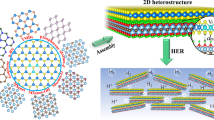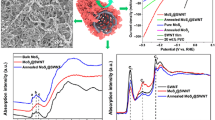Abstract
In this paper, mechanisms behind enhancement of catalytic activity of MoS2 mono-layer (three atomic layers) for hydrogen evolution reaction (HER) by mechanically applying bending strain were investigated using density functional theory. Results showed that with the increase of bending strains, the Gibbs free energy for hydrogen adsorption on the MoS2 mono-layer was decreased from 0.18 to −0.04 eV and to 0.13 eV for the bend strains applied along the zigzag and armchair directions, respectively. The mechanism for the enhanced catalytic activity comes from the changes of density of electronic states near the Fermi energy level, which are induced by the changes of the Mo-S and Mo-Mo bonds upon bending. This report provides a new design methodology to improve the catalytic activity of catalysts based on two-dimensional transition metal dichalcogenides through a simple mechanical bending.




Similar content being viewed by others
References
An YR, Fan XL, Luo ZF, Lau WM (2017) Nanopolygons of monolayer MS2: best morphology and size for HER catalysis. Nano Lett 17:368–376
Capitani F, Höppner M, Joseph B, Malavasi L, Artioli GA, Baldassarre L, Perucchi A, Piccinini M, Lupi S, Dore P (2013) Combined experimental and computational study of the pressure dependence of the vibrational spectrum of solid picene C22H14. Phys Rev B 88:4745–4751
Chen X, Wang Z, Qiu Y, Zhang J, Liu G, Zheng W, Feng W, Cao W, Hu P, Hu W (2016) Controlled growth of vertical 3D MoS2(1−x)Se2x nanosheets for an efficient and stable hydrogen evolution reaction. J Mater Chem A 4:18060–18066
Chou SS, Sai N, Lu P, Coker EN, Liu S, Artyushkova K, Luk TS, Kaehr B, Brinker CJ (2015) Understanding catalysis in a multiphasic two-dimensional transition metal dichalcogenide. Nat Commun 6:8311
Deng J, Yuan W, Ren P, Wang Y, Deng D, Zhang Z, Bao X (2014) High-performance hydrogen evolution electrocatalysis by layer-controlled MoS2 nanosheets. RSC Adv 4:34733–34738
Deng J, Li H, Xiao J, Tu Y, Deng D, Yang H, Tian H, Li J, Ren P, Bao X (2015) Triggering the electrocatalytic hydrogen evolution activity of the inert two-dimensional MoS2 surface via single-atom metal doping. Energy Environ Sci 8:1594–1601
Dunn S (2002) Hydrogen futures: toward a sustainable energy system. Int J Hydrogen Ene 27:235–264
Enyashin AN, Yadgarov L, Houben L, Popov I, Weidenbach M, Tenne R, Bar-Sadan M, Seifert G (2011) New route for stabilization of 1T-WS2 and MoS2 phases. J Phys Chem C 115:24586–24591
Fang YH, Liu ZP (2009) Surface phase diagram and oxygen coupling kinetics on flat and stepped Pt surfaces under electrochemical potentials. J Phys Chem C 113:9765–9772
Gao MR, Liang JX, Zheng YR, Xu YF, Jiang J, Gao Q, Li J, Yu SH (2015a) An efficient molybdenum disulfide/cobalt diselenide hybrid catalyst for electrochemical hydrogen generation. Nat Commun 6:36666
Gao G, Jiao Y, Ma F, Jiao Y, Waclawik E, Du A (2015b) Charge mediated semiconducting-to-metallic phase transition in molybdenum disulfide monolayer and hydrogen evolution reaction in new 1T′-phase. J Phys Chem C 119:13124–13128
Greeley J, Jaramillo TF, Bonde J, Chorkendorff IB, Nørskov JK (2006) Computational high-throughput screening of electrocatalytic materials for hydrogen evolution. Nat Mater 5:909–913
He K, Poole C, Mak KF, Shan J (2013) Experimental demonstration of continuous electronic structure tuning via strain in atomically thin MoS2. Nano Lett 13:2931–2936
Hu T, Li R, Dong J (2013) A new (2×1) dimerized structure of monolayer 1T-molybdenum disulfide, studied from first principles calculations. J Chem Phys 139:174702
Jaramillo TF, Jørgensen KP, Bonde J, Nielsen JH, Horch S, Chorkendorff I (2007) Identification of active edge sites for electrochemical H2 evolution from MoS2 nanocatalysts. Science 317:100–102
Jiang L, Myer B, Tellefsen K, Pau S (2009) A planar microfabricated electrolyzer for hydrogen and oxygen generation. J Power Sources 188:256–260
Jiao Y, Zheng Y, Jaroniec M, Qiao SZ (2015) Design of electrocatalysts for oxygen- and hydrogen-involving energy conversion reactions. Chem Soc Rev 44:2060–2086
Kresse G, Furthmüller J (1996) Efficient iterative schemes for ab initio total-energy calculations using a plane-wave basis set. Phys Rev B 54:11169–11186
Kye J, Shin M, Lim B, Jang JW, Oh I, Hwang S (2013) Platinum monolayer electrocatalyst on gold nanostructures on silicon for photoelectrochemical hydrogen evolution. ACS Nano 7:6017–6023
Laursen AB, Kegnæs S, Dahl S, Chorkendorff I (2012) Molybdenum sulfides-efficient and viable materials for electro - and photoelectrocatalytic hydrogen evolution. Energy Environ Sci 5:5577–5591
Lee JH, Jang WS, Han SW, Baik HK (2014) Efficient hydrogen evolution by mechanically strained MoS2 nanosheets. Langmuir 30:9866–9873
Li Y, Wang H, Xie L, Liang Y, Hong G, Dai H (2011) MoS2 nanoparticles grown on graphene: an advanced catalyst for the hydrogen evolution reaction. J Am Chem Soc 133:7296–7299
Li BB, Qiao SZ, Zheng XR, Yang XJ, Cui ZD, Zhu SL, Li ZY, Liang YQ (2015) Pd coated MoS2 nanoflowers for highly efficient hydrogen evolution reaction under irradiation. J Power Sources 284:68–76
Lin YC, Dumcenco DO, Huang YS, Suenaga K (2014) Atomic mechanism of the semiconducting-to-metallic phase transition in single-layered MoS2. Nat Nanotech 9:391–396
Lloyd D, Liu X, Christopher JW, Cantley L, Wadehra A, Kim BL, Goldberg BB, Swan AK, Bunch JS (2016) Band gap engineering with ultralarge biaxial strains in suspended monolayer MoS2. Nano Lett 16:5836–5841
Nørskov JK, Bligaard T, Logadottir A, Kitchin JR, Chen JG, Pandelov S, Stimming U (2005) Trends in the exchange current for hydrogen evolution. J Electroch Soc 152:J23
Pack JD, Monkhorst HJ (1977) "special points for Brillouin-zone integrations"- a reply. Phys Rev B 16:1748–1749
Pan H (2014) Metal dichalcogenides monolayers: novel catalysts for electrochemical hydrogen production. Sci Rep 4:5348
Pan H (2016) Tension-enhanced hydrogen evolution reaction on vanadium disulfide monolayer. Nanoscale Res Lett 11:113
Pan H, Feng YP, Lin J (2010) Enhancement of hydrogen evolution on tungsten doped platinum. J Comput Theo Nanosci 7:547–551
Perdew JP, Burke K, Ernzerhof M (1996) Generalized gradient approximation made simple. Phys Rev Lett 77:3865
Putungan DB, Lin SH, Kuo JL (2015) A first-principles examination of conducting monolayer 1T'-MX2 (M = Mo, W; X = S, se, Te): promising catalysts for hydrogen evolution reaction and its enhancement by strain. Phys Chem Chem Phys 17:21702–21708
Qian X, Liu J, Fu L, Li J (2014) Quantum spin hall effect in two-dimensional transition metal dichalcogenides. Science 346:1344–1347
Sahoo MPK, Wang J, Zhang Y, Shimada T, Kitamura T (2016) Modulation of gas adsorption and magnetic properties of monolayer-MoS2 by antisite defect and strain. J Phys Chem C 120:14113–14121
Schmickler W, Trasatti S (2006) Comment on Trends in the Exchange Current for Hydrogen Evolution. J Electrochem Soc 153:L31
Skulason E, Karlberg GS, Rossmeisl J, Bligaard T, Greeley J, Jonsson H, Norskov JK (2007) Density functional theory calculations for the hydrogen evolution reaction in an electrochemical double layer on the Pt(111) electrode. Phys Chem Chem Phys 9:3241–3250
Skúlason E, Tripkovic V, Björketun ME, Gudmundsdóttir S, Karlberg G, Rossmeisl J, Bligaard T, Jónsson H, Nørskov JK (2010) Comment on Trends in the Exchange Current for Hydrogen Evolution. J Electrochem Soc 153:L31
Song I, Park C, Choi HC (2015) Synthesis and properties of molybdenum disulphide: from bulk to atomic layers. RSC Adv 5:7495–7514
Tang Q, Jiang D (2016) Mechanism of hydrogen evolution reaction on 1T-MoS2 from first principles. ACS Catal 6:4953–4961
Tong CJ, Zhang H, Zhang YN, Liu H, Liu LM (2014) New manifold two-dimensional single-layer structures of zinc-blende compounds. J Mater Chem A 2:17971–17978
Tsai C, Abild-Pedersen F, Norskov JK (2014) Tuning the MoS2 edge-site activity for hydrogen evolution via support interactions. Nano Lett 14:1381–1387
Tsai C, Chan K, Nørskov JK, Abild-Pedersen F (2015a) Rational design of MoS2 catalysts: tuning the structure and activity via transition metal doping. Catal Sci Technol 5:246–253
Tsai C, Chan K, Nørskov JK, Abild-Pedersen F (2015b) Theoretical insights into the hydrogen evolution activity of layered transition metal dichalcogenides. Surf Sci 640:133–140
Voiry D, Yamaguchi H, Li J, Silva R, Alves DC, Fujita T, Chen M, Asefa T, Shenoy VB, Eda G, Chhowalla M (2013a) Enhanced catalytic activity in strained chemically exfoliated WS2 nanosheets for hydrogen evolution. Nat Mater 12:850–855
Voiry D, Salehi M, Silva R, Fujita T, Chen M, Asefa T, Shenoy VB, Eda G, Chhowalla M (2013b) Conducting MoS2 nanosheets as catalysts for hydrogen evolution reaction. Nano Lett 13:6222–6227
Wang H, Tsai C, Kong D, Chan K, Abild-Pedersen F, Nørskov JK, Cui Y (2015) Transition-metal doped edge sites in vertically aligned MoS2 catalysts for enhanced hydrogen evolution. Nano Res 8:566–575
Wypych F, Schollhorn R (1992) 1T-MoS2, a new metallic modification of molybdenum disulfide. J Chem Soc, Chem Commun 1386-1388
Xia X, Zhao X, Ye W, Wang C (2014) Highly porous ag-Ag2S/MoS2 with additional active sites synthesized by chemical etching method for enhanced electrocatalytic hydrogen evolution. Electrochim Acta 142:173–181
Zhang T, Anderson AB (2007) Hydrogen oxidation and evolution on platinum electrodes in base: theoretical study. J Phys Chem C 111:8644–8648
Zhang J, Sasaki K, Sutter E, Adzic RR (2007) Stabilization of platinum oxygen-reduction electrocatalysts using gold clusters. Science 315:220–222
Acknowledgements
This work was financially supported by the National Natural Science Foundation of China (NFSC 11474047). Funding supports from UK Engineering Physics and Science Research Council (EPSRC EP/P018998/1), Newton Mobility Grant (IE161019) through Royal Society and NFSC, and Royal academy of Engineering UK-Research Exchange with China and India are also acknowledged. This work was carried out at National Supercomputer Center in Tianjin, and the calculations were performed on TianHe-1(A).
Funding
This study was funded by National Natural Science Foundation of China (11474047) and the Fundamental Research Funds for the Central Universities (ZYGX2016J202), and Newton Mobility Grant (IE161019).
Author information
Authors and Affiliations
Corresponding authors
Ethics declarations
Conflict of interest
The authors declare that they have no conflict of interest.
Rights and permissions
About this article
Cite this article
Shi, W., Wang, Z. & Fu, Y.Q. Mechanical bending induced catalytic activity enhancement of monolayer 1 T’-MoS2 for hydrogen evolution reaction. J Nanopart Res 19, 296 (2017). https://doi.org/10.1007/s11051-017-3996-2
Received:
Accepted:
Published:
DOI: https://doi.org/10.1007/s11051-017-3996-2




